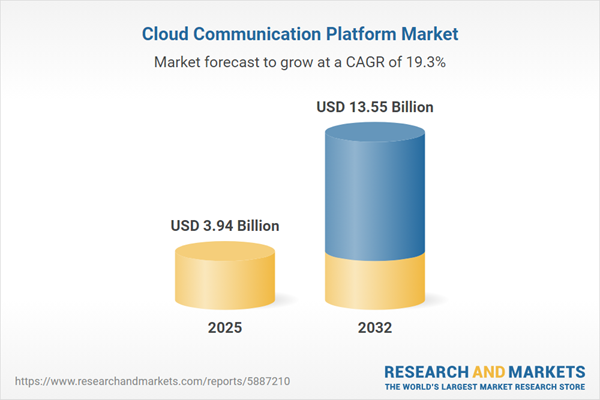Speak directly to the analyst to clarify any post sales queries you may have.
Cloud communication solutions empower modern enterprises to unify digital channels, streamline collaboration, and bolster resilience. For senior decision-makers seeking to enhance operational agility and continuity, cloud platforms deliver adaptable, scalable connectivity to support dynamic needs and drive efficient workflows.
Market Snapshot: Cloud Communication Platform Market Size and Trends
The cloud communication platform market demonstrates robust expansion, driven by the proliferation of cloud-native architectures among enterprises and increased investment in secure digital communication. In 2024, the market stands at USD 3.30 billion, projected to reach USD 13.55 billion by 2032, with a compound annual growth rate of 19.29%. Key trends include the integration of artificial intelligence capabilities, growing reliance on advanced analytics for business insights, and accelerating demand for omnichannel engagement tools. The evolution toward hybrid and remote team structures increases the value of agile, integrated communications—facilitating innovation, business continuity, and efficient adaptation to changing environments.
Scope & Segmentation: Key Dimensions for Cloud Communication Platform Adoption
- Pricing Models: Enterprises gain flexibility from Freemium, Pay-As-You-Go, and Subscription options, enabling tailored investments that align with specific operational requirements and budget constraints.
- Deployment Models: Hybrid, Private, and Public Cloud approaches accommodate a range of IT oversight, security postures, and compliance responsibilities to suit different organizational strategies.
- Communication Types: Solutions encompass Communications Platform as a Service, Messaging, Chat, Video and Voice APIs, Unified Communication as a Service, and Contact Center applications. These options facilitate integration and streamline business processes across diverse workflows.
- Organization Sizes: Platforms deliver scalability and feature sets suitable for Small, Medium, and Large Enterprises, supporting effective cost management and integration depth.
- Industry Verticals: Financial, government, healthcare, IT & telecom, retail, and insurance sectors benefit from industry-specific compliance and operational adaptations, addressing unique regulatory and communication demands.
- Geographic Regions: The Americas, Europe, Middle East & Africa, and Asia-Pacific exhibit varied adoption patterns based on local regulations, digital infrastructure, and solution customization requirements.
- Leading Companies: Organizations such as Microsoft Corporation, Cisco Systems, Zoom Video Communications, Twilio, Sinch AB, Vonage, RingCentral, Mitel Networks, 8x8, and Bandwidth actively respond to evolving enterprise communication needs with ongoing innovation.
Key Takeaways: Strategic Insights for Senior Decision-Makers
- Unified cloud platforms bring together messaging, video, and voice for seamless team collaboration and adaptable business operations.
- Embedding artificial intelligence and leveraging open APIs accelerates process optimization and supports strategies for ongoing digital transformation.
- Hybrid deployment options offer customizable balances among scalability, compliance, and IT management, improving alignment with enterprise risk considerations.
- Focusing on advanced security features and compliance tools is crucial for sectors governed by strict regulations, enabling proactive risk management.
- Customizable capabilities support development of industry-specific processes, driving operational efficiency and aligning with precise sector requirements.
- Expansion into new geographies necessitates careful assessment of infrastructure capabilities and regulatory landscapes, emphasizing the significance of strategic technology partnerships during rollout.
Tariff Impact: Navigating Adjustments in US Networking Hardware
Recent changes in US tariffs on networking hardware prompt enterprises to reexamine their supply chains and vendor relationships. In response, organizations enhance regional sourcing practices, conduct deeper supplier reviews, and implement robust project management protocols to sustain continuity and control costs amid evolving trade dynamics.
Methodology & Data Sources
This insight is based on a synthesis of executive interviews, industry research, comprehensive company analysis, and structured user surveys. Subject matter experts validated findings to ensure an objective and thorough perspective on opportunities and challenges in the cloud communication platform market.
Cloud Communication Platform Market: Why This Report Matters
- Enables executive teams to benchmark technology vendors against current and emerging offerings, empowering well-informed, strategic investment decisions in cloud communication platforms.
- Outlines regional deployment strategies and compliance considerations, guiding organizations in technology choices aligned with operational and regulatory needs.
- Supplies actionable, sector-specific recommendations for building effective communications strategies, supporting both immediate business goals and sustainable market relevance.
Conclusion
Senior leaders can apply these market insights to deploy resilient, scalable communication platforms, improving organizational efficiency and adaptability amid continual business evolution.
Additional Product Information:
- Purchase of this report includes 1 year online access with quarterly updates.
- This report can be updated on request. Please contact our Customer Experience team using the Ask a Question widget on our website.
Table of Contents
3. Executive Summary
4. Market Overview
7. Cumulative Impact of Artificial Intelligence 2025
Companies Mentioned
The companies profiled in this Cloud Communication Platform market report include:- Microsoft Corporation
- Cisco Systems, Inc.
- Zoom Video Communications, Inc.
- Twilio Inc.
- Sinch AB
- Vonage Holdings Corp.
- RingCentral, Inc.
- Mitel Networks Corporation
- 8x8, Inc.
- Bandwidth Inc.
Table Information
| Report Attribute | Details |
|---|---|
| No. of Pages | 194 |
| Published | October 2025 |
| Forecast Period | 2025 - 2032 |
| Estimated Market Value ( USD | $ 3.94 Billion |
| Forecasted Market Value ( USD | $ 13.55 Billion |
| Compound Annual Growth Rate | 19.2% |
| Regions Covered | Global |
| No. of Companies Mentioned | 11 |









